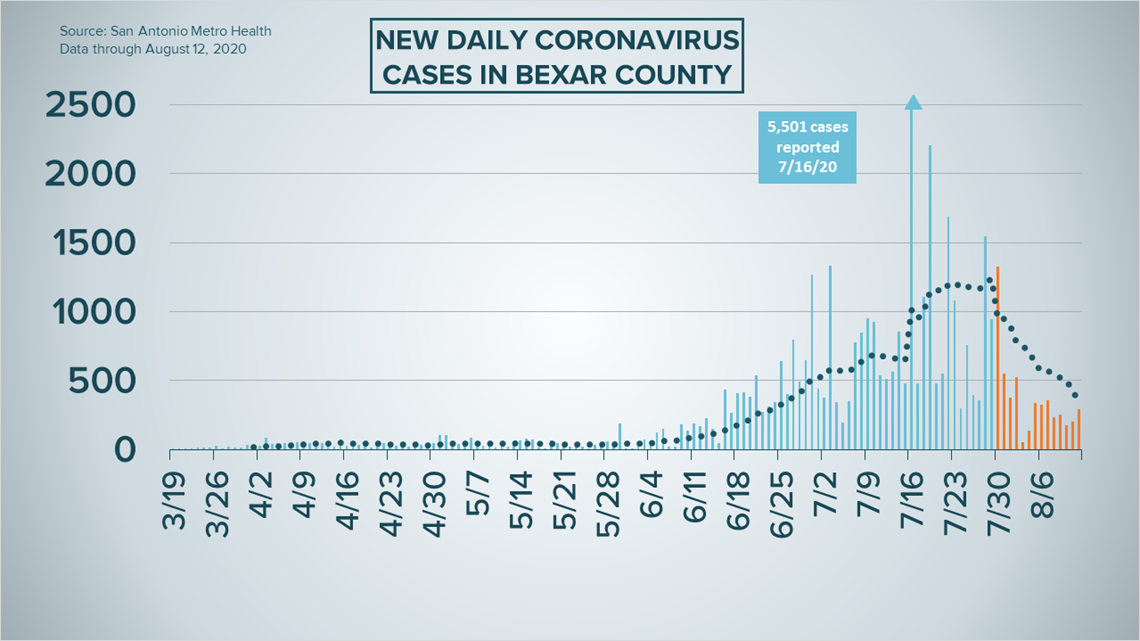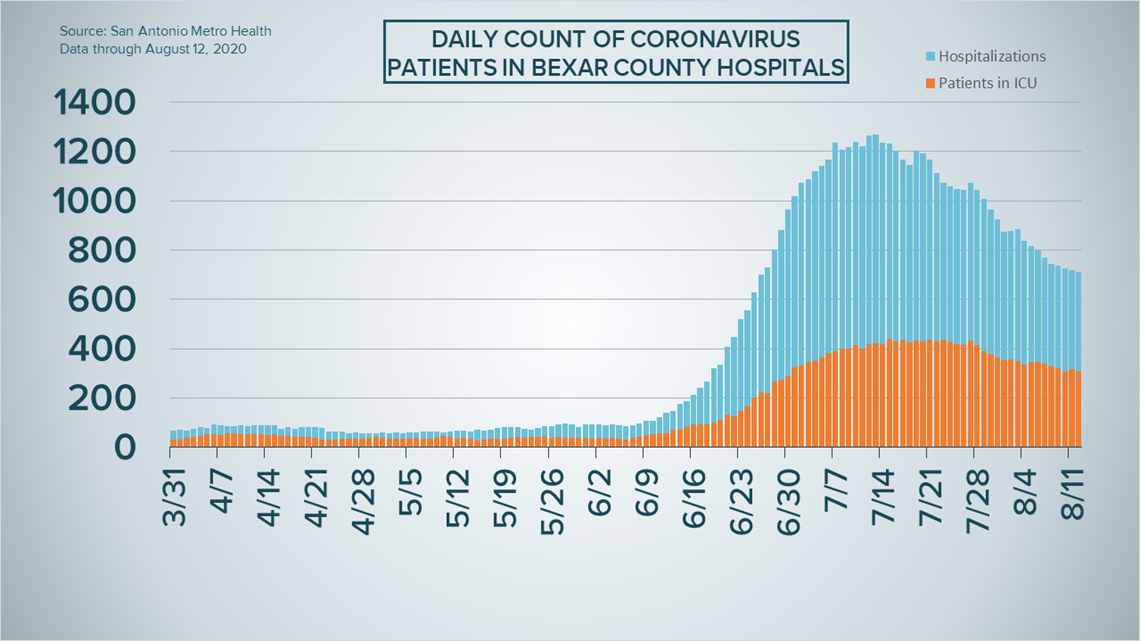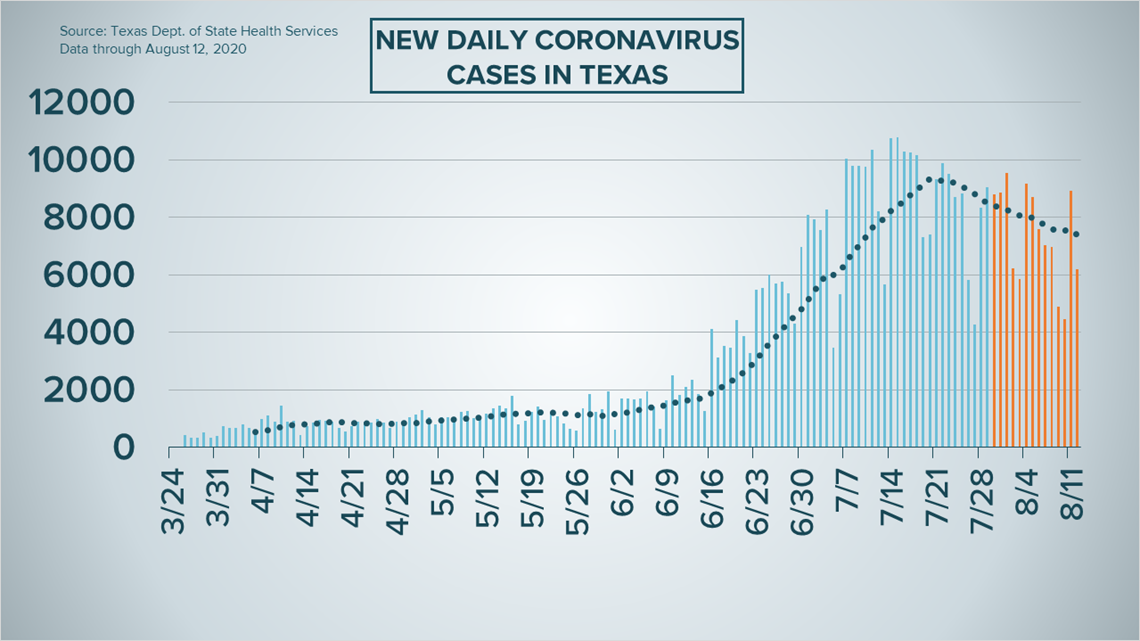SAN ANTONIO — We're tracking the latest numbers from the coronavirus pandemic in San Antonio and across Texas. Here are the latest numbers reported by Bexar and surrounding counties:
- Bexar County: 291 new cases were reported Wednesday, bringing the total number for the county to 43,455. The county death toll, meanwhile, rose to 545 after 26 additional fatalities were reported; those deaths stretch back to June 12.
- Comal County: The county reported 82 new cases on Wednesday. There have been a total of 2,556 cases of COVID-19 in the county – including 1,993 confirmed cases – while 71 county residents have died. County officials say there are 458 active coronavirus cases, and 2,027 residents have recovered.
- Hays County: Officials in Hays County on Wednesday reported 17 new cases in the county and two additional virus-related deaths. As of Wednesday evening, there were a total of 5,083 lab-confirmed cases in the county (2,700 of which were active) while the death toll increased to 37.
How Bexar County is trending
We're tracking how many coronavirus cases are confirmed in Bexar County each day from the time San Antonio Metro Health began reporting cases more than five months ago. Graphing those daily case numbers along a 14-day moving average provides an accurate picture of the curve in the San Antonio area and the direction we're heading amid the coronavirus.
On Wednesday, Mayor Ron Nirenberg reported an additional 291 cases of the novel coronavirus in Bexar County, bringing the total to 43,455. Despite the fact that's more than the 205 cases reported on Tuesday, the seven-day average for the county for daily cases has decreased from 266 to 259.
The local death toll, meanwhile, rose to 545 after Nirenberg confirmed an additional 26 deaths from COVID-19 complications. Those deaths date back to as early as mid-June; 261 local deaths are still being investigated for potential coronavirus connections.


Hospitalizations continued to trend downward for Bexar County; on Wednesday, 710 residents were receiving treatment for virus symptoms. The number of residents on ventilators (213) and in intensive care (309) were also down slightly from Tuesday.


Coronavirus in Texas
Texas health authorities on Wednesday reported an additional 6,200 cases of the coronavirus from across the state, bringing the total to 506,820. The death toll, meanwhile, eclipsed 9,000 after 324 more deaths from COVID-19 complications were reported.
In all, 9,034 Texans have succumbed to the virus.


However, the rate of hospitalized Texans continues to go down. On Wednesday, 7,028 residents were receiving treatment for COVID-19 symptoms, nearly 200 fewer than on Tuesday. The last time the number of hospitalized Texans was that low was the start of July.
Lastly, an estimated 367,354 Texans have recovered from the virus during the ongoing pandemic.
Latest Coronavirus Headlines
- Wear The Gown: Breastfeeding with the coronavirus
- Coronavirus testing in Texas plummets as schools prepare to reopen
- US shuts down 300 websites exploiting COVID-19 pandemic, DOJ says
- 'The lifeblood of this whole area': Lake Amistad small businesses struggling to survive amid weekend closures
- Young vapers up to 7 times more likely to get COVID-19, nationwide survey finds
- Antibody drugs to treat COVID-19 could roll out by early fall
- Central Texas teachers leave jobs amidst the pandemic
- 'Talkin shop with Dr. Fauci' | Matthew McConaughey to speak with nation's top disease expert on Instagram Live
- Texas Gov says COVID-19 numbers in SE Texas heading in right direction but hospitalizations too high
- Virus surge makes US weak link in global economic recovery
Coronavirus symptoms
The symptoms of coronavirus can be similar to the flu or a bad cold. Symptoms include fever or chills, cough, shortness of breath or difficulty breathing, fatigue, muscle or body aches, headache, new loss of taste or smell sore throat, congestion or runny nose, nausea or vomiting and diarrhea, according to the Centers for Disease Control.
Most healthy people will have mild symptoms. A study of more than 72,000 patients by the Centers for Disease Control in China showed 80 percent of the cases there were mild.
But infections can cause pneumonia, severe acute respiratory syndrome, kidney failure, and even death, according to the World Health Organization. Older people with underlying health conditions are most at risk.
On June 25, the CDC expanded the list of groups at a higher risk of severe illness due to coronavirus.
Experts determined there was consistent evidence these conditions increase a person's risk, regardless of age:
- Chronic kidney disease
- COPD (chronic obstructive pulmonary disease)
- Obesity (BMI of 30 or higher)
- Immunocompromised state (weakened immune system) from solid organ transplant
- Serious heart conditions, such as heart failure, coronary artery disease, or cardiomyopathies
- Sickle cell disease
- Type 2 diabetes
The CDC believes symptoms may appear anywhere from two to 14 days after being exposed.
Human coronaviruses are usually spread...
- Between people who are in close contact with one another (within about 6 feet).
- Through respiratory droplets produced when an infected person coughs, sneezes or talks. These droplets can land in the mouths or noses of people who are nearby or possibly be inhaled into the lungs.
- Some recent studies have suggested that COVID-19 may be spread by people who are not showing symptoms.
Help stop the spread of coronavirus
- Stay home when you are sick.
- Eat and sleep separately from your family members
- Use different utensils and dishes
- Cover your cough or sneeze with your arm, not your hand.
- If you use a tissue, throw it in the trash.

